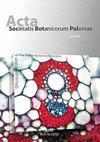松林与阔叶凋落物在混合分解过程中的相互效应
IF 0.8
4区 生物学
Q3 PLANT SCIENCES
引用次数: 3
摘要
混合分解效应通常在天然林和人工林中观察到,并影响森林生态系统中的养分循环。然而,人们对一种垃圾类型如何影响另一种垃圾的分解仍知之甚少。在本研究中,将华山松枯枝落叶与白桦树、番红花、蒲杨、杜仲和清华枫枯枝落叶混合。将混合物放入垃圾袋中,并埋在湿度一致的土壤中,进行180天的室内模拟分解实验。垃圾袋在分解过程中定期收获;对不同物种的枯枝落叶残体进行了分离,并模拟了各枯枝落叶类型的生物量动态。此外,还对土壤蔗糖酶、纤维素酶和多酚氧化酶活性进行了三次检测。研究了针阔叶落叶在混合分解过程中的相互作用及其可能的潜在机制。结果表明:(i)在分解实验中,华山松针叶在前3个月显著抑制了阔叶落叶的分解,而阔叶落叶仅在约40%的情况下加速了华山松针叶的分解。然而,针叶对阔叶枯枝落叶分解的抑制作用随后显著减弱,而对阔叶枯叶落叶的加速作用则显著增强。混合分解对三种酶活性的影响只能部分解释不同凋落物类型之间的相互作用;(ii)分解模型的预测表明,在整个混合分解过程中,大多数阔叶枯枝落叶类型都能持续加速P.armandii针叶的分解,而阔叶枯枝的分解至少在短期内会受到显著抑制。总的来说,五种阔叶落叶类型中的四种(不包括杜仲)可以加速华山松针叶的早期分解,从而加速华山松纯林中的营养循环。这些物种可用于将纯华山松纯林转化为混交林。本文章由计算机程序翻译,如有差异,请以英文原文为准。
Mutual effects between Pinus armandii and broadleaf litter during mixed decomposition
Mixed-decomposition effects are commonly observed in natural and planted forests and affect nutrient cycling in a forest ecosystem. However, how one litter type affects the decomposition of another is still poorly understood. In this study, Pinus armandii litter was mixed with Betula albosinensis, Catalpa fargesii, Populus purdomii, Eucommia ulmoides, and Acer tsinglingense litter. The mixtures were placed in litterbags and buried in soil with consistent moisture for a 180-day indoor simulated decomposition experiment. The litterbags were periodically harvested during decomposition; the litter residues of different species were separated, and the biomass dynamics of each litter type were simulated. In addition, the soil sucrase, cellulase and polyphenol oxidase activities were also detected three times. The mutual effects of needle and broadleaf litter during mixed decomposition and the possible underlying mechanisms were investigated. The results indicated that (i) during the decomposition experiment, P. armandii needles significantly inhibited the decomposition of broadleaf litter in the first 3 months, while the broadleaf litter accelerated the decomposition of P. armandii needles in only approximately 40% of the cases. However, the inhibitory effects of needles on broadleaf litter decomposition subsequently exhibited significant weakening, while the accelerating effects of broadleaf litter were significantly enhanced. The effects of mixed decomposition on the activities of three enzymes can only partially explain the interactions between different litter types; (ii) the prediction by the decomposition model showed that most of the broadleaf litter types could continuously accelerate the decomposition of P. armandii needles throughout the mixed decomposition process, while the decomposition of broadleaf litter would be significantly inhibited at least in the short term. In general, four of the five broadleaf litter types (excluding E. ulmoides) could accelerate the early decomposition of P. armandii needles and consequently accelerate nutrient cycling in P. armandii pure forests. These species could be used for the transformation of pure P. armandii pure forests to mixed forests.
求助全文
通过发布文献求助,成功后即可免费获取论文全文。
去求助
来源期刊
CiteScore
2.00
自引率
10.00%
发文量
18
审稿时长
1 months
期刊介绍:
The journal has been published since 1923 and offers Open Access publication of original research papers, short communications, and reviews in all areas of plant science, including evolution, ecology, genetics, plant structure and development, physiology and biochemistry.

 求助内容:
求助内容: 应助结果提醒方式:
应助结果提醒方式:


